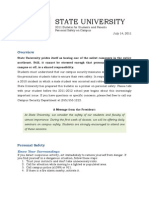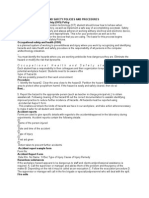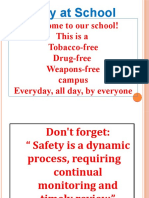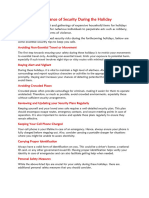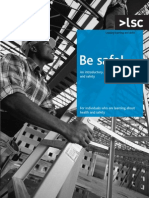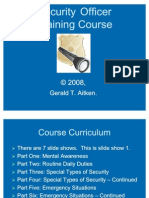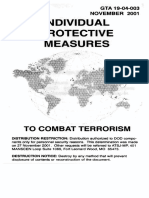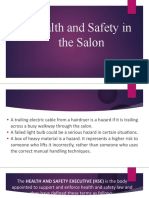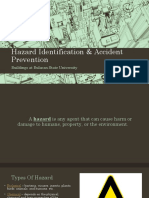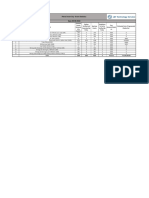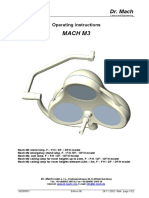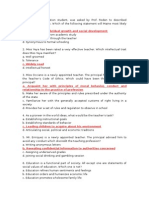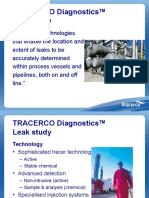Internship Safety
Internship Safety
Uploaded by
Ravi Ranjan ojhaCopyright:
Available Formats
Internship Safety
Internship Safety
Uploaded by
Ravi Ranjan ojhaOriginal Title
Copyright
Available Formats
Share this document
Did you find this document useful?
Is this content inappropriate?
Copyright:
Available Formats
Internship Safety
Internship Safety
Uploaded by
Ravi Ranjan ojhaCopyright:
Available Formats
Internship Safety Guide
Basic steps in risk awareness:
Identify potential risks. Talk to your faculty supervisor and employer about specific risks related
to your field.
Understand guidelines and expectations form the university and employer perspectives.
Inform your faculty supervisor or internship advisor of any concern immediately.
Know the numbers for emergency services at internship location and program into your phone
where appropriate.
Should an incident occur:
Contact Department of Public Safety or local police if assistance needed.
Be sure to document all facts such as date, time, persons involved, and the situation as you
observed it.
Inform your internship advisor or faculty supervisor immediately.
Examples of Safety Risks:
Harassment
Sexual, age, ethnic, racial, or disability harassment of student interns, or any employee is illegal
The employer must ensure that regular, full-time employees, or other interns, do not harass you
during your internship.
Immediately report any harassment to your faculty supervisor and internship supervisor.
Protect Your Personal Identity
Protect social security number, cell phone numbers, and other identifiers.
For safety reasons, do not disclose your own personal contact information. This includes any
social media information, such as your Twitter or Facebook accounts.
Sexual Assault
Individuals who commit acts of sexual violence are responsible for their actions. While it may not be
possible to prevent a sexual assault, there are some steps that can be taken that might reduce the risk.
Respect yourself and others.
Trust your instincts. If a place or person makes you feel uncomfortable, remove yourself from
the situation.
Be aware of nonverbal clues that can alert you to a potential aggressor, such as someone who is
sitting or standing too close, staring at you, or pressuring you to be alone together.
Talk with your friends about watching out for one another as much as possible.
Let your friends know where you are going and whom you are with.
Consider carefully what you post online about yourself. It is not advised to post your phone
number, address, class schedule, or where you are.
Internship Safety Guide
Travel
Consider dangerous intersections, streets, or stretches of highway to and from the site.
Make sure you have directions and secured transportation to and from the site.
Make sure someone has your contact information at the site. Also, leave site information with a
roommate or a friend.
Notice parking garages or poorly-lit parking areas.
Visually check parking lot when you arrive
Do not park next to a van or truck
Be alert and aware of surroundings
Visually check building when arrive
Have key or swipe card ready
Do not converse with strangers
Physical Hazards
Working outdoors – sun, snow and ice, other extreme weather, pollution, power lines, etc.
Working indoors – any type of machinery, unsuitable working conditions such as extreme
temperatures, asbestos, insecure buildings where there may be structural concerns, closed off
or blocked fire escapes, etc.
Biological Hazards
Animals you may work with/upon- dead or alive
Poisonous plants
Infected birds or fish
If in the medical field, check to see how bio-hazardous waste is disposed
Chemical Hazards
Water supply
Toner powers from laser printer cartridges or photocopies – eye or lung irritation
Chemicals in a laboratory setting – eyes, open sores, inhalation
You might also like
- Pogil Heat and CalorimetryDocument4 pagesPogil Heat and Calorimetryapi-341706426No ratings yet
- Highly Recommended Extra Worksheets Answer Key PDFDocument5 pagesHighly Recommended Extra Worksheets Answer Key PDFIJ ThomasNo ratings yet
- Ukraine Embassy Documents On Biological Threat Reduction ProgramDocument11 pagesUkraine Embassy Documents On Biological Threat Reduction ProgramKyle Becker100% (10)
- Working AloneDocument3 pagesWorking Aloneanon_803215984100% (1)
- The Sixth House - Psychology of Self-Integration - Robert Glasscock - B00F07KNZ0 - EBOKDocument155 pagesThe Sixth House - Psychology of Self-Integration - Robert Glasscock - B00F07KNZ0 - EBOKAndrew Khabaza100% (11)
- CJCS 5260 Pocket CardDocument1 pageCJCS 5260 Pocket CardColt Armstrong InmanNo ratings yet
- Standard Operating ProceduresDocument15 pagesStandard Operating ProceduresAiza Bargamento BalalaNo ratings yet
- Off The Job SafetyDocument25 pagesOff The Job SafetyGideon Pradas Padua100% (2)
- Dd422i Specification Sheet EnglishDocument4 pagesDd422i Specification Sheet EnglishMohan PreethNo ratings yet
- Exploring w02 Grader IRDocument3 pagesExploring w02 Grader IRdeeVLNo ratings yet
- ADW Extreme Situation GuideDocument19 pagesADW Extreme Situation GuideHasmik SimonyanNo ratings yet
- Terrorism: Submitted By: BORJA, Carmina SDocument7 pagesTerrorism: Submitted By: BORJA, Carmina SCeeNo ratings yet
- Personal Safety PlanningDocument8 pagesPersonal Safety PlanningRifa Cesa IkasilaNo ratings yet
- Safety During A Violent IncidentDocument5 pagesSafety During A Violent IncidentKah CaudillaNo ratings yet
- CSS OhsDocument2 pagesCSS OhsDja FilesNo ratings yet
- Personal SecurityDocument11 pagesPersonal Securitydonlyn100% (2)
- Occupational Health and Safety Policies and ProceduresDocument2 pagesOccupational Health and Safety Policies and Proceduresedz100% (4)
- Womens Situational Awareness and Personal Safety SeminarDocument16 pagesWomens Situational Awareness and Personal Safety Seminarmishraakash424No ratings yet
- Safety and Security: Occupational Safety & Health AdministrationDocument8 pagesSafety and Security: Occupational Safety & Health AdministrationLavitSutcharitkulNo ratings yet
- Ict 9Document3 pagesIct 9Ezekiel QuinolaNo ratings yet
- Occupational Health and Safety PoliciesDocument4 pagesOccupational Health and Safety PoliciesAnonymous vmfPnwAdxJNo ratings yet
- Mdc-Policies-Health SafetyDocument3 pagesMdc-Policies-Health Safetyapi-325880402No ratings yet
- The Growth of The Security IndustryDocument20 pagesThe Growth of The Security IndustryYIJLashawnNo ratings yet
- Workplace ViolenceDocument2 pagesWorkplace Violencechiheb maaloulNo ratings yet
- Welcome To Our School! This Is A Tobacco-Free Drug-Free Weapons-Free Campus Everyday, All Day, by EveryoneDocument17 pagesWelcome To Our School! This Is A Tobacco-Free Drug-Free Weapons-Free Campus Everyday, All Day, by Everyonesarvesh_24No ratings yet
- Q31 Inspect and Test Configured Computer System and NetworkDocument18 pagesQ31 Inspect and Test Configured Computer System and Networkandenglachica224No ratings yet
- HAZWOPER First Responder Awareness US Job Aid PS5-103070Document3 pagesHAZWOPER First Responder Awareness US Job Aid PS5-103070rhythamsoniNo ratings yet
- Centennial Court: Community PoliciesDocument5 pagesCentennial Court: Community PoliciesRohanMehtaNo ratings yet
- Mdc-Policies-Child ProtectionDocument7 pagesMdc-Policies-Child Protectionapi-325880402No ratings yet
- Importance of Security During The HolidaysDocument4 pagesImportance of Security During The HolidaysFrank OhiriNo ratings yet
- Lab Safety HandoutDocument1 pageLab Safety HandoutAlex WilliamsNo ratings yet
- Safety Hazards:: They IncludeDocument4 pagesSafety Hazards:: They Includejoel lacayNo ratings yet
- Group 4Document3 pagesGroup 4joy diagbelNo ratings yet
- Safe School WebquestDocument4 pagesSafe School Webquestapi-543841868No ratings yet
- Occupational Health and Safety Policies and ProceduresDocument3 pagesOccupational Health and Safety Policies and ProceduresCarl Daniel Amorosa100% (2)
- INSTALL COMPUTER SYSTEMS AND NETWORKS Grade 9Document17 pagesINSTALL COMPUTER SYSTEMS AND NETWORKS Grade 9alessandra idgafNo ratings yet
- Be Safe Guide To Health and SafetyDocument46 pagesBe Safe Guide To Health and SafetymirfieldfreeNo ratings yet
- Guard Course Part 1Document29 pagesGuard Course Part 1Kalpesh Chauhan100% (1)
- Health 4.1Document3 pagesHealth 4.1Nathan LingatongNo ratings yet
- Safety Handbook For NTU Students' Attachment and Internship: First Published: Dec 2010Document27 pagesSafety Handbook For NTU Students' Attachment and Internship: First Published: Dec 2010David KohNo ratings yet
- Safety Booklet enDocument16 pagesSafety Booklet enOswald mNo ratings yet
- Week 017-Personal Safety Protocol and EtiquetteDocument11 pagesWeek 017-Personal Safety Protocol and EtiquetteRouie john dizonNo ratings yet
- Country Parks Risk AssessDocument6 pagesCountry Parks Risk AssessJyoti SharmaNo ratings yet
- Safety Practices For Professional OrganizersDocument31 pagesSafety Practices For Professional OrganizerspolitologaqrooNo ratings yet
- Restricted DoD Guide - Individual Protective Measures To Combat Terrorism GTA 19-04-003 PDFDocument24 pagesRestricted DoD Guide - Individual Protective Measures To Combat Terrorism GTA 19-04-003 PDFSHTF PLANNo ratings yet
- Value Based Safety: Off The Job SafetyDocument87 pagesValue Based Safety: Off The Job SafetyLorenz BanadaNo ratings yet
- Handling Suspicious Items and Packages in HotelsDocument3 pagesHandling Suspicious Items and Packages in HotelsRaheim HyattNo ratings yet
- A HazardDocument2 pagesA HazardloraineNo ratings yet
- General Safety TrainingDocument65 pagesGeneral Safety Trainingsanu1985No ratings yet
- Emergency Procedures: or Other Advised AreaDocument2 pagesEmergency Procedures: or Other Advised AreaIspsc Candon Guidance CounselingNo ratings yet
- Unit VIII Word FileDocument8 pagesUnit VIII Word FileVinluan Erika AnnNo ratings yet
- Safety ManagementDocument10 pagesSafety ManagementGABAON JERRYL KESHA GNo ratings yet
- 00 Orientation FdnyDocument9 pages00 Orientation FdnyHualy Delgado100% (1)
- Hazard Awareess Toolbox TalkDocument2 pagesHazard Awareess Toolbox Talkpruncu.alianmNo ratings yet
- Workplace Hygiene: News & NotesDocument4 pagesWorkplace Hygiene: News & NotesNoman MehmoodNo ratings yet
- LEO Bombing Preparedness and Response PlanDocument6 pagesLEO Bombing Preparedness and Response PlanJaylord ABRIGADONo ratings yet
- Health and Safety in The Salon PpointDocument27 pagesHealth and Safety in The Salon PpointMARIALUPE ESTOQUENo ratings yet
- 9 Risk Areas Home and RecreationalDocument9 pages9 Risk Areas Home and RecreationalFatima VeneracionNo ratings yet
- Health and Safety in The SalonDocument5 pagesHealth and Safety in The SalonMARIALUPE ESTOQUE100% (1)
- Apply Occupational Health and Safety Procedures Iticor0021aDocument49 pagesApply Occupational Health and Safety Procedures Iticor0021aapi-247871582100% (3)
- Hazard Identification & Accident Prevention: Buildings at Bulacan State UniversityDocument16 pagesHazard Identification & Accident Prevention: Buildings at Bulacan State UniversityCamille CarreonNo ratings yet
- Safety OrientationDocument17 pagesSafety Orientationyxp2237No ratings yet
- Cumulative Challan 3Document1 pageCumulative Challan 3Ravi Ranjan ojhaNo ratings yet
- 06 June 24Document3 pages06 June 24Ravi Ranjan ojhaNo ratings yet
- Cumulative Challan 2Document1 pageCumulative Challan 2Ravi Ranjan ojhaNo ratings yet
- Challant ChartDocument1 pageChallant ChartRavi Ranjan ojhaNo ratings yet
- Consent1720245949 102423Document3 pagesConsent1720245949 102423Ravi Ranjan ojhaNo ratings yet
- Bihar Competency 2022-2025Document2 pagesBihar Competency 2022-2025Ravi Ranjan ojhaNo ratings yet
- Project-Sustainability-Standard V3.1Document32 pagesProject-Sustainability-Standard V3.1Ravi Ranjan ojhaNo ratings yet
- Intrinsically Safe EthernetDocument6 pagesIntrinsically Safe EthernetJairo FlechasNo ratings yet
- IMO Soal MCQDocument4 pagesIMO Soal MCQWenny MonicaNo ratings yet
- Iata Live Animals Acceptance Check ListDocument1 pageIata Live Animals Acceptance Check ListindrayanaThea100% (1)
- Dr. Mach M3 - User ManualDocument22 pagesDr. Mach M3 - User ManualMohamed AhmedNo ratings yet
- Kids Box Ezine Reports Previous Issues of Ezine Natural Disasters WorksheetDocument1 pageKids Box Ezine Reports Previous Issues of Ezine Natural Disasters Worksheetsivi6194No ratings yet
- Product Overview - COMFORT OVERVIEWDocument16 pagesProduct Overview - COMFORT OVERVIEWDam Ngoc KienNo ratings yet
- Stiff 1951Document4 pagesStiff 1951Brenda RoblesNo ratings yet
- Molecular Orbital TheoryDocument26 pagesMolecular Orbital TheorySri Santika FujiantiNo ratings yet
- Profe Duc 2015Document19 pagesProfe Duc 2015Randy0% (1)
- 911 GT3 RSDocument12 pages911 GT3 RSahmer0258No ratings yet
- Group 2 - Lab 5 - Burger Patties ProductionDocument9 pagesGroup 2 - Lab 5 - Burger Patties Productionxxzxiin0810No ratings yet
- Defense PresentationDocument18 pagesDefense PresentationMohsin Ali RazaNo ratings yet
- Poverty CSSDocument7 pagesPoverty CSSsohailbabarNo ratings yet
- 7th Grade Earth SystemsDocument86 pages7th Grade Earth SystemsStephen BestNo ratings yet
- Exodus Elementary School: Department ODocument3 pagesExodus Elementary School: Department OMichelle Esplana100% (5)
- How To Register Your Company or LLPDocument8 pagesHow To Register Your Company or LLPanoop82No ratings yet
- 2,100 Asanas - The Complete Yoga - Daniel LacerdaDocument1,095 pages2,100 Asanas - The Complete Yoga - Daniel LacerdaNguyễn Thị Châu Tây100% (12)
- Hands-On BOP Workshop: Authors: Jaap Peetsold and Anton GreeffDocument8 pagesHands-On BOP Workshop: Authors: Jaap Peetsold and Anton GreeffKaleem UllahNo ratings yet
- Electrical WorksDocument16 pagesElectrical WorkskrmcharigdcNo ratings yet
- English-Book-II-Part-1-Modern-ProseDocument21 pagesEnglish-Book-II-Part-1-Modern-Prosewaqashussainvikki786No ratings yet
- Unified Heart Chakra MeditationDocument3 pagesUnified Heart Chakra MeditationJanaki KothariNo ratings yet
- Dinding Penahan TanahDocument12 pagesDinding Penahan TanahBeny HidayatNo ratings yet
- Quiz Informatics Sample 02 ADocument2 pagesQuiz Informatics Sample 02 AjanmalexxNo ratings yet
- Tracerco Diagnostics Leak StudyDocument14 pagesTracerco Diagnostics Leak StudyMiki Jaksic100% (1)
- Strategic Intervention Material For Grade - 7 Technology Livelihood EducationDocument35 pagesStrategic Intervention Material For Grade - 7 Technology Livelihood EducationNorman Polilin100% (2)










